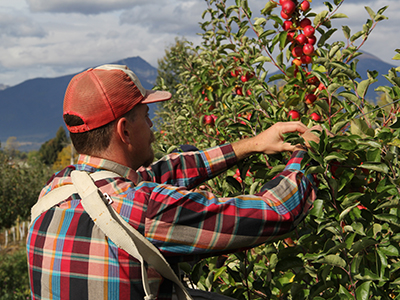Fruit Wines
Northern Shrub Fruit: Applications for Wine
By Bob Thaden, Tongue River Vineyard & Winery – Miles City, Montana
Click here to access the PDF slide presentation
With the right fruit, techniques, and care, you can produce complex, flavorful wines from hardy northern fruits like chokeberries, haskaps, juneberries (A.K.A. serviceberries, saskatoons), and cherries. These Northern shrub fruits offer incredible diversity and resilience, and they’re perfectly suited for small-scale growers and craft winemakers in colder climates. Whether you’re planting your first bush or pressing your first gallon, these fruits can help you build a unique and sustainable wine business—or just stock your cellar with amazing homegrown vintages.
Getting Started: Key questions to ask yourself before planting or pressing:
- Are you already growing fruit? If so, what kinds?
- Why do you want to grow fruit – for a hobby or commercial use?
- How much do you plan to grow?
- How will you use the fruit? Fresh sales, jam, wine?
- If commercial, who are your potential buyers? Have you asked what ripeness or quality standards they need?
Site Selection: Reliable water supply is a must.
- Know your water rights.
- Test water pH.
- Consider using filters and drip irrigation.
- Understand your system's efficiency—calculate how many gallons/hour your setup can deliver and how many feet of fruit rows you can irrigate.
Climate and Season Length: Use Growing Degree Days (GDD) to estimate heat units available in your area.
- Haskaps need fewer GDDs (~1500–1700).
- Grapes often need 2200+ GDDs.
- Check your average frost dates and match fruit varieties to your actual season length.
- Tool: GreenCast
Soil Basics
- Test your soil with a simple jar test to show sand, silt, and clay ratios.
- pH Range: Most fruits prefer pH 6.0–7.0; some berries thrive in acidic soils.
- Soil Health: Add compost and check for nutrient availability with tissue and soil tests.
Pest & Wildlife Management
- Fencing: Deer fencing is essential—use heavy-duty plastic and wire H-braces.
- Netting: Protect crops from birds with full-row netting.
- Pests: Watch for robins, cane borers, hornworms, and spotted wing drosophila.
- Rabbits: Cottontails love bark and can kill young plants—protect your base stems.
|
Fruit |
Flavor Profile
|
Hardiness / Growing
|
Soil / Water Needs
|
Wine Characteristics
|
Other Notes
|
|---|---|---|---|---|---|
|
Amelanchier
(Juneberry) |
Mild blueberry with apple/almond
|
Very hardy
|
Tolerant of high pH; needs water during fruiting
|
Light, berry-forward wines. |
Birds are major pests
|
|
Aronia
(Chokeberry) |
Astringent, tannic
|
Hardy to -40°F
|
Moist, enriched soil
|
Can make great or awful wine; very pigmented
|
Very high in antioxidants; best fermented on skins.
|
|
Lonicera (Haskap)
|
Blueberry, raspberry, strawberry
|
Extremely hardy; early ripening
|
pH tolerant
|
Excellent for wine, juice, jelly
|
Nearly invisible seeds
|
|
Malus (Apple)
|
Depends on variety; crabs are tart
|
Varies
|
General orchard soil
|
Great for cider or ice wine
|
Russets preferred for cider
|
|
Prunus (Cherries)
|
Acid + sugar balance (e.g., Carmine Jewel)
|
Hardy to -50°F
|
Rich, well-drained
|
Excellent cherry wines
|
Late picking enhances sugar; best when nearly black.
|
|
Prunus (Chokecherries)
|
Astringent, earthy
|
Hardy
|
Adapted to wild growth
|
Traditional wine source
|
Black, red, and rare yellow varieties
|
|
Prunus (Sand Cherry)
|
Strong black cherry flavor
|
Extremely hardy
|
Tolerant
|
Tannic, intense flavor
|
Beautiful spring blossoms
|
|
Prunus (Plum)
|
Tart, pulpy
|
Hardy
|
Moist, well-drained
|
Great semi-sweet wine; suspended solids
|
Needs good fining (e.g., bentonite)
|
|
Pyrus (Pears)
|
Crisp, aromatic
|
Hardy
|
General orchard needs
|
Golden Spice makes rich, dry/semi-sweet wine
|
Shred and ferment on pulp for best results.
|
|
Ribes (Currants & Gooseberries)
|
Tart (black, red, white)
|
Hardy
|
Lower pH preferred
|
Sharp, vivid wines
|
Primocane and floricane types offer different fruiting windows; fruit attractive to
birds
|
|
Rosa (Rose Hips)
|
Strawberry-like, very tannic
|
Hardy
|
Requires frost to develop flavor
|
Unique, tannic wine
|
Rugosa produces largest hips
|
|
Rubus (Raspberries, Blackberries)
|
Sweet-tart
|
Hardy, varies by type
|
Acid-loving—prep soil with compost, peat moss, and sulfur
|
Complex, aromatic wines
|
Primocane vs Floricane types affect harvest
|
|
Rhubarb
|
Tart, refreshing
|
Hardy
|
Rich, manured soils
|
Crisp, unique wine base
|
Common in homestead wines; good in fruit blends
|
|
Sambucus (Elderberry)
|
Earthy, musky
|
Hardy
|
Moist, rich soils
|
Generally poor for wine
|
Better for jelly
|
|
Vitis (Grapes)
|
Varies by cultivar
|
Depends on cultivar; Frontenacs are extremely cold-hardy
|
Well-drained, pH 6–7
|
Classic wine grapes (Frontenac, La Crescent, etc.)
|
Even grapes struggle some years—have a backup plan with shrub fruits!
|

